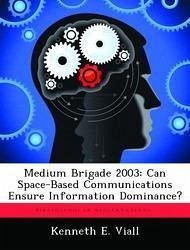This thesis analyzes space-based communications support for medium brigade combat team forces over the next three years. The army's reaction to changes in the national security environment and increased technology as outlined in Joint Vision 2010 has been to pursue digitization of the force and develop a new, "Medium Weight" brigade-rapidly deployable, reliant on high-capacity information architecture, and capable of early entry and stability and support operations. The study examined the role of satellite communications in the objective command and control system that considered the nature of the higher headquarters, adjacent units, and internal brigade requirements. Using the proposed Initial Brigade Combat Team concept, the study reviewed task organization, signal support structure, bandwidth requirements, and the operational employment of satellite communications assets during Operation Restore Hope, Somalia; Operation Uphold Democracy, Haiti; and Operation Joint Endeavor, Bosnia-Hercegovina. The study concluded that space-based communications will remain pivotal to successful command and control and projected signal organizations and equipment of the medium brigade can provide effective support. However, the army must address shortfalls in national satellite infrastructure, reconcile task organization difficulties, and integrate digitization efforts to effectively manage available communications capacities.
Hinweis: Dieser Artikel kann nur an eine deutsche Lieferadresse ausgeliefert werden.
Hinweis: Dieser Artikel kann nur an eine deutsche Lieferadresse ausgeliefert werden.








